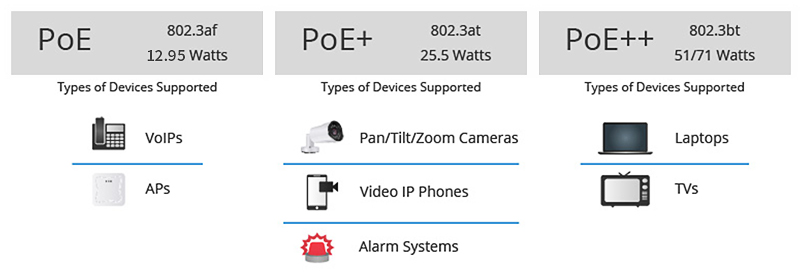PoE, PoE+, PoE++ Switches: How to Choose?

PoE, or Power over Ethernet, is a proven, time- and money-saving technology that securely transmits data and power over a local area network (LAN) over the same Ethernet cable. In the current market, if you pay attention to the types of PoE switches, you will find PoE switches, PoE+ switches, and PoE++ switches. But how much do you know about these three types of PoE switches? What is the difference between PoE, PoE+, and PoE++? And how do you make the right choice?

What are PoE and PoE switches?
What is PoE? PoE technology was defined by the IEEE 802.3af standard in 2003. According to this standard, PoE allows PDs (Powered Devices) such as VoIP phones to receive up to 12.95W PoE power, utilizing only two of the four twisted pair pairs available in Ethernet cabling.
So what is a PoE switch? A PoE switch is an application of PoE technology. As a type of PSE (power supply device), PoE switches can supply power to PD devices through Ethernet cables to achieve network interconnection. In general, 802.3af switches support a maximum power consumption of 15.4W per PoE port with a voltage range of 44V to 57V. The PD voltage range connected to the PoE switch is 37V to 57V.

What are PoE+ and PoE+ switches?
PoE+ Technology (IEEE 802.3at standard) is an upgraded version of PoE technology, released in 2009. PDs in the market tend to require higher wattage, such as wireless access points that require more than 12.95W PoE wattage to work properly. To solve this problem, PoE+ technology was born, which can support high power consumption.
Similar to PoE network switches, the PoE plus switch is also powered by two pairs, but it adds an additional power level capable of delivering PDs with a voltage range of 42.5V to 57V Delivers up to 25.5W of power. PoE+ switches provide a maximum of 30W of power per port and a voltage range of 50V to 57V.
What are PoE++ and PoE++ switches?
In order to provide more power to a wider range of device applications, the IEEE 802.3 standard once again calls for upgrading its PoE+ technology to PoE++ (IEEE) in 2018 802.3bt standard). PoE++ can be divided into two types: Type 3 and Type 4. Type 3 enables two or all four pairs of twisted pair in copper to deliver up to 51W on PD power. Type 4 has up to 71W of power on the PD via four twisted pairs in an Ethernet cable.
PoE++ network switches are the next generation of PoE+ technology. PoE++ switches support up to 60 watts per port under Type 3 and provide the highest level of power for PoE switches - Up to 100W per PoE port under Type 4.
PoE, PoE+, and PoE++ switches: Which one to choose?
Since the selection of PoE switches needs to be based on different needs, this section provides information on the best choices for the four types of PoE switches from both specifications and applications.
Specifications of PoE, PoE+, and PoE++ switches
Based on the above introduction, a reference diagram is given below that summarizes the detailed specifications of PoE, PoE+, and PoE++ switches.
| PoE | PoE+ | PoE++ | |
IEEE standards | IEEE 802.3af | IEEE 802.3at | IEEE 802.3bt | |
PoE type | Type1 | Type2 | Type3 | Type4 |
Switch port power | ||||
Maximum power per port | 15.4W | 400 | 60W | 100W |
Port voltage range | 44–57V | 50-57V | 50-57V | 52-57V |
Power supply to the powered device | ||||
The maximum power supply of the device | 12.95W | 25.5W | 210 | 71W |
Device voltage range | 37-57V | 42.5-57V | 42.5-57V | 41.1-57V |
cable | ||||
Use twisted pairs | 2 pairs | 2 pairs | 4 pairs | 4 pairs |
Supported cables | Cat3 or better | Cat5 or better | Cat5 or better | Cat5 or better |
Note: The numbers provided are of theoretical value only, and the total power capacity of the PoE Series switches in the application will be oversubscribed, and many devices will use less than the maximum number of ports. For example, if your switch is equipped with all PoE++ Type 4 ports, it doesn't mean you'll be using all of them at 24×7 maximum load. Therefore, you need to calculate the power requirements of all the powered devices you plan to connect to the switch and choose the appropriate jumpers for your PoE design.
PoE vs. PoE+ and PoE++ switch applications
Obviously, the main difference between PoE and PoE+ and PoE++ switches is their mode of operation and power supply, which is reflected in their applications.
(1) PoE switches
802.3af switches, also known as PoE-type switches, are typically used to support devices with a power output of less than 15.4W:
- Basic VoIP phones that operate over the public internet
- Dual-antenna wireless access points for small networks
- Fixed security cameras without panning, tilting and zooming
- Sensors, meters, etc.
(2) PoE+ switches
A PoE+ switch with an output power of 30W can power Type 2 devices, such as:
- IP phones that provide fax, text messaging, and voice calls
- Six-antenna wireless access points
- Remotely controlled pan, tilt and zoom (PTZ) surveillance cameras
- Biosensors that collect biometrics
(3) PoE++ switches
With up to 60W of power, the PoE++ Type 3 switch can power the following devices:
- Two-way video phone calls in conferencing systems
- Building management devices such as gates or door controllers
- Thin clients remotely connect to server-based computing environments
- Remote patient monitoring devices
PoE++ Type 4 switches can support devices such as laptops and TVs.

If a low standard power level is sufficient for the needs of your data center, a PoE switch is a good choice. Otherwise, when a more robust and high-performance network with multiple different devices is required, PoE+ or A PoE++ switch would be better without considering port limitations. They are also a smart choice for building more demanding infrastructure and planning upgrades. Of course, if the existing PoE The network design is adequate and meets your needs, and you can keep your existing PoE network design.
FS PoE++ switches
The main features of the three FS PoE++ switches are as follows:
| S5860-24XB-U | S3200-8MG4S-U | S5850-24XMG-U |
category | 24-port Ethernet L3 PoE++ switch | 8-port Ethernet L2+ managed PoE++ switch | 24-port Ethernet L3 PoE++ switch |
port | 24 x 100M/1000M/2.5G/5G/10GBase-T, 4 x 1G/10G SFP+ | 4 x 10G/25G SFP28 | 8 x 100/1000M/2.5GBASE-T | 4 x 10Gb SFP+ | 24 x 10/100/1000M/2.5G/5G/10GBASE-T | 2 x 100G QSFP28 |
Exchange capacity | 760 Gbps | 120Gbps | 880Gbps |
Power budget | 740W | 250W | 1000W |
apply | Laptops, tablet entertainment devices | Radio access points, PTZ cameras, video conferencing equipment | IP phones, wireless access points |
conclusion
The growing demand for power has led to the evolution of PoE technology from PoE to PoE+ and PoE++. PoE-based switches have also been upgraded from PoE network switches to PoE+ switches and PoE++ switches. This article explains the differences between PoE, PoE+, and PoE++ switches and their applications. Hopefully, this article will give you some inspiration in choosing the right PoE network switch.